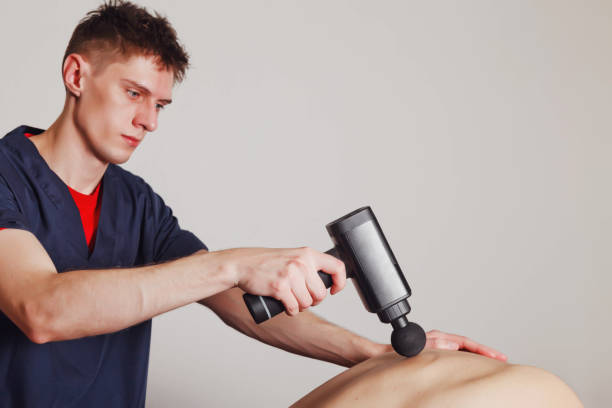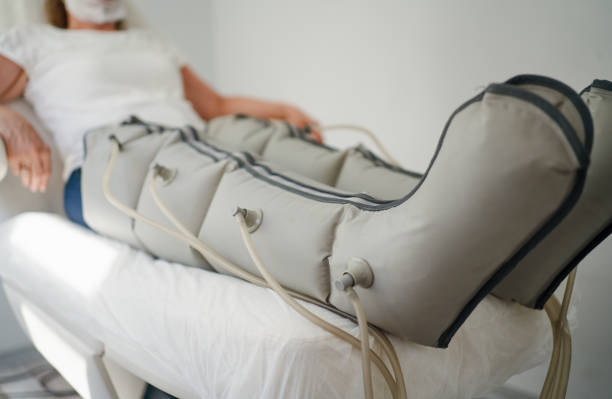In the realm of physical therapy and rehabilitation, two prominent modalities stand out: compression therapy and percussion therapy. Each offers unique benefits and applications, catering to diverse needs across various demographics. In this comprehensive guide, we delve into the intricacies of both therapies, exploring their definitions, relevance, and therapeutic potential.
Define the Therapies
Compression Therapy
- Definition of compression therapy.
- Historical background and evolution.
- Various forms of compression therapy: static compression, intermittent pneumatic compression (IPC), dynamic compression.
- Applications in medical and sports settings.
Percussion Therapy
- Explanation of percussion therapy.
- Origins and development.
- Different techniques: manual percussion, mechanical percussion devices.
- Utilization in physical therapy and sports medicine.
Relevance and Importance
Impact on Rehabilitation
- How compression therapy aids in recovery from injuries and surgeries.
- The role of percussion therapy in reducing muscle tension and improving range of motion.
- Importance in enhancing blood circulation and lymphatic drainage.
Sports Performance Enhancement
- Relevance of compression therapy in preventing muscle fatigue and soreness among athletes.
- Impact of percussion therapy on athletic performance and injury prevention.
- Significance in promoting faster recovery post-exercise.
Types and Categories
Types of Compression Therapy
Static Compression
- Explanation of static compression garments.
- Benefits for edema management and venous disorders.
- Medical applications and patient considerations.
Intermittent Pneumatic Compression (IPC)
- Description of IPC devices and their mechanism of action.
- Use in deep vein thrombosis (DVT) prevention and lymphedema treatment.
- Clinical efficacy and contraindications.
Dynamic Compression
- Overview of dynamic compression systems.
- Applications in sports recovery and performance enhancement.
- Emerging trends and innovations in dynamic compression technology.

Techniques of Percussion Therapy
Manual Percussion
- Traditional methods of manual percussion.
- Hands-on techniques used by physical therapists.
- Effectiveness in breaking up muscle adhesions and promoting relaxation.
Mechanical Percussion Devices
- Introduction to mechanical percussion devices (e.g., percussion massagers).
- Features and functionalities of popular percussion massage guns.
- Consumer considerations and product comparisons.
Symptoms and Signs
Symptoms Addressed by Compression Therapy
Edema
- Definition of edema and its underlying causes.
- How compression therapy alleviates swelling and discomfort.
- Patient testimonials and success stories.
Venous Insufficiency
- Symptoms of venous insufficiency: varicose veins, leg ulcers, heavy legs.
- Role of compression stockings in managing venous disorders.
- Clinical studies supporting the efficacy of compression therapy.
Indications for Percussion Therapy
Muscle Tension
- Common signs of muscle tension and stiffness.
- How percussion therapy promotes muscle relaxation and pain relief.
- User reviews and anecdotal evidence.
Reduced Range of Motion
- Impact of restricted range of motion on daily activities.
- Percussion therapy techniques for improving flexibility and mobility.
- Rehabilitation protocols for patients with limited range of motion.
Causes and Risk Factors
Factors Contributing to Edema
Surgery and Trauma
- Surgical procedures associated with postoperative swelling.
- How trauma and injury lead to localized edema.
- Compression therapy recommendations for surgical patients.
Pregnancy
- Physiological changes during pregnancy leading to edema.
- Role of compression garments in managing pregnancy-related swelling.
- Precautions and guidelines for expectant mothers.
Contributors to Muscle Tension
Overuse and Repetitive Strain
- Impact of repetitive movements on muscle health.
- Occupational risk factors for chronic muscle tension.
- Incorporating percussion therapy into ergonomic practices.
Poor Posture
- Effects of prolonged sitting and standing on posture.
- How poor posture contributes to muscle imbalances.
- Ergonomic solutions and posture correction strategies.
Diagnosis and Tests
Diagnostic Procedures for Edema
Physical Examination
- Clinical assessment of swelling and tissue characteristics.
- Importance of accurate measurement techniques.
- Differentiating between pitting and non-pitting edema.
Imaging Studies
- Role of ultrasound in evaluating vascular integrity.
- Diagnostic value of venous Doppler studies.
- Indications for advanced imaging modalities (e.g., MRI, CT scan).
Evaluation of Muscle Conditions
Manual Muscle Testing
- Objective assessment of muscle strength and function.
- Grading system for muscle testing results.
- Incorporating percussion therapy into muscle rehabilitation programs.
Range of Motion Assessment
- Techniques for measuring joint flexibility and mobility.
- Importance of assessing active and passive range of motion.
- Using percussion therapy to improve joint mobility.
Treatment Options
Therapeutic Interventions for Edema
Compression Garments
- Types of compression garments: stockings, sleeves, wraps.
- Prescription guidelines based on compression level and anatomical site.
- Compliance issues and patient education.
Manual Lymphatic Drainage (MLD)
- Principles of MLD and its therapeutic effects.
- Techniques for performing manual lymphatic drainage.
- Integrating percussion therapy into MLD protocols.
Surgical Interventions
- Surgical options for severe or refractory edema.
- Indications for procedures like lymph node transfer and vascular bypass.
- Postoperative care and rehabilitation considerations.
Modalities for Muscle Relief
Percussion Massage
- Benefits of percussion massage for muscle recovery.
- Different percussion massage techniques: tapping, vibration, kneading.
- Guidelines for safe and effective percussion massage sessions.
Stretching and Flexibility Exercises
- Importance of flexibility training for muscle health.
- Stretching protocols for various muscle groups.
- Enhancing stretching routines with percussion therapy.
Heat and Cold Therapy
- Application of heat packs and cold packs in muscle rehabilitation.
- Mechanisms of action and physiological effects.
- Combined approach: contrast therapy with percussion massage.
Preventive Measures
Strategies for Edema Prevention
Lifestyle Modifications
- Importance of regular exercise and movement.
- Dietary considerations for reducing fluid retention.
- Avoiding prolonged sitting or standing positions.
Compression Maintenance
- Tips for proper care and maintenance of compression garments.
- Frequency of garment replacement and washing.
- Travel recommendations for individuals using compression therapy.
Muscle Health Promotion
Ergonomic Practices
- Creating ergonomic workstations to prevent muscle strain.
- Using proper lifting techniques to avoid injury.
- Incorporating regular breaks and stretching exercises into daily routines.
Hydration and Nutrition
- Impact of hydration and nutrition on muscle function.
- Recommended dietary components for muscle recovery and repair.
- Hydration strategies before and after physical activity.
Personal Stories or Case Studies
Edema Management Success Stories
Patient A: Overcoming Chronic Swelling
- Personal journey of a patient with lymphedema.
- Role of compression therapy and lifestyle modifications.
- Testimonials from the patient and healthcare providers.
Patient B: Postoperative Recovery
- Experience of a surgical patient managing postoperative edema.
- Rehabilitation protocol including compression garments and manual therapy.
- Before-and-after photos illustrating treatment outcomes.
Percussion Therapy Transformations
Athlete Recovery Journey
- Story of an athlete incorporating percussion therapy into their training regimen.
- Improvement in performance metrics and injury prevention.
- Endorsement from the athlete and their coaching staff.
Chronic Pain Management
- Testimony from an individual suffering from chronic muscle tension.
- Impact of percussion therapy on pain reduction and functional improvement.
- Long-term outcomes and quality-of-life improvements.
Expert Insights
Medical Professional Perspectives
Dr. Smith: Vascular Surgeon
- Insights on the role of compression therapy in vascular health.
- Patient selection criteria and treatment algorithms.
- Future directions in compression therapy research.
PT Specialist: Sports Rehabilitation
- Expert opinion on integrating percussion therapy into sports medicine.
- Benefits for athletes recovering from injuries or undergoing training.
- Practical recommendations for percussion therapy utilization.
Conclusion
In conclusion, compression therapy and percussion therapy offer multifaceted solutions for addressing various physical ailments and promoting overall well-being. By understanding their mechanisms, applications, and benefits, individuals can make informed decisions regarding their healthcare and rehabilitation journeys.

